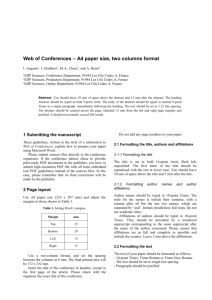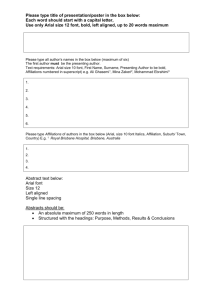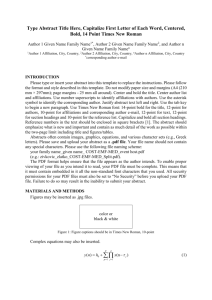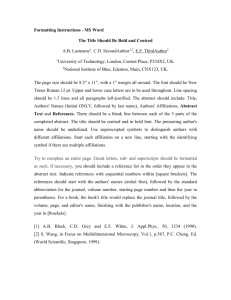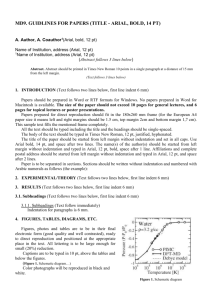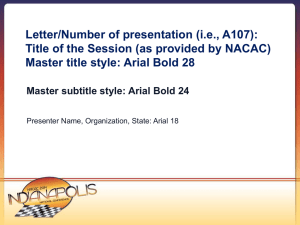SHS Web of Conferences
advertisement
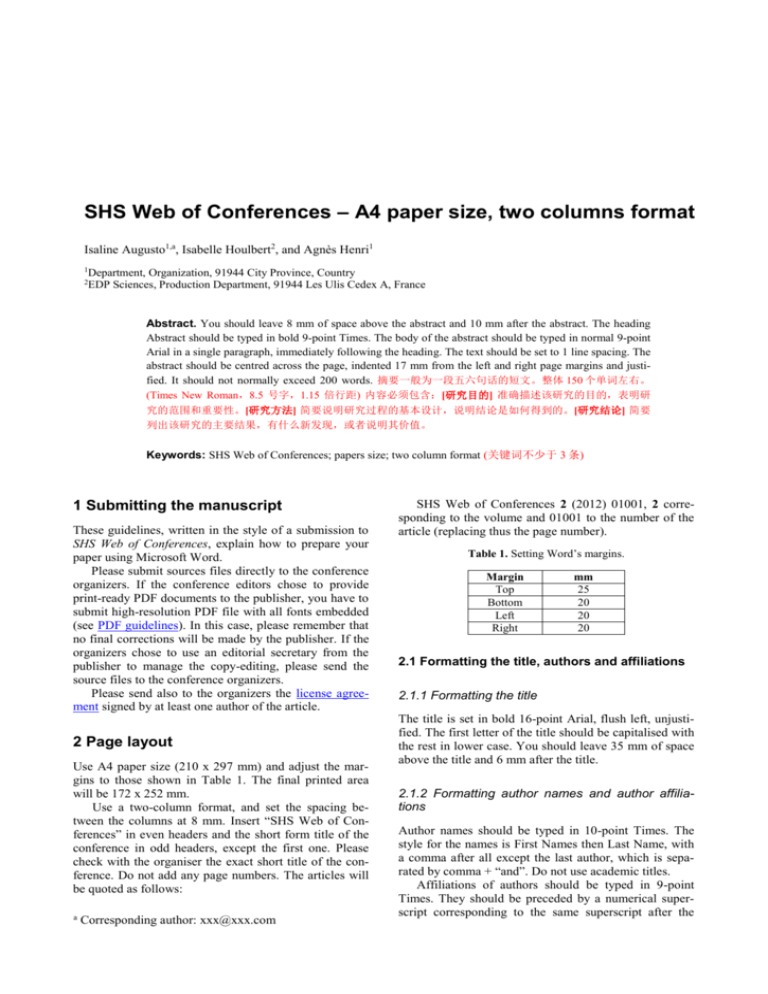
SHS Web of Conferences – A4 paper size, two columns format
Isaline Augusto1,a, Isabelle Houlbert2, and Agnès Henri1
1Department,
2EDP
Organization, 91944 City Province, Country
Sciences, Production Department, 91944 Les Ulis Cedex A, France
Abstract. You should leave 8 mm of space above the abstract and 10 mm after the abstract. The heading
Abstract should be typed in bold 9-point Times. The body of the abstract should be typed in normal 9-point
Arial in a single paragraph, immediately following the heading. The text should be set to 1 line spacing. The
abstract should be centred across the page, indented 17 mm from the left and right page margins and justified. It should not normally exceed 200 words. 摘要一般为一段五六句话的短文。整体 150 个单词左右。
(Times New Roman,8.5 号字,1.15 倍行距) 内容必须包含:[研究目的] 准确描述该研究的目的,表明研
究的范围和重要性。[研究方法] 简要说明研究过程的基本设计,说明结论是如何得到的。[研究结论] 简要
列出该研究的主要结果,有什么新发现,或者说明其价值。
Keywords: SHS Web of Conferences; papers size; two column format (关键词不少于 3 条)
1 Submitting the manuscript
These guidelines, written in the style of a submission to
SHS Web of Conferences, explain how to prepare your
paper using Microsoft Word.
Please submit sources files directly to the conference
organizers. If the conference editors chose to provide
print-ready PDF documents to the publisher, you have to
submit high-resolution PDF file with all fonts embedded
(see PDF guidelines). In this case, please remember that
no final corrections will be made by the publisher. If the
organizers chose to use an editorial secretary from the
publisher to manage the copy-editing, please send the
source files to the conference organizers.
Please send also to the organizers the license agreement signed by at least one author of the article.
2 Page layout
Use A4 paper size (210 x 297 mm) and adjust the margins to those shown in Table 1. The final printed area
will be 172 x 252 mm.
Use a two-column format, and set the spacing between the columns at 8 mm. Insert “SHS Web of Conferences” in even headers and the short form title of the
conference in odd headers, except the first one. Please
check with the organiser the exact short title of the conference. Do not add any page numbers. The articles will
be quoted as follows:
a
Corresponding author: xxx@xxx.com
SHS Web of Conferences 2 (2012) 01001, 2 corresponding to the volume and 01001 to the number of the
article (replacing thus the page number).
Table 1. Setting Word’s margins.
Margin
Top
Bottom
Left
Right
mm
25
20
20
20
2.1 Formatting the title, authors and affiliations
2.1.1 Formatting the title
The title is set in bold 16-point Arial, flush left, unjustified. The first letter of the title should be capitalised with
the rest in lower case. You should leave 35 mm of space
above the title and 6 mm after the title.
2.1.2 Formatting author names and author affiliations
Author names should be typed in 10-point Times. The
style for the names is First Names then Last Name, with
a comma after all except the last author, which is separated by comma + “and”. Do not use academic titles.
Affiliations of authors should be typed in 9-point
Times. They should be preceded by a numerical superscript corresponding to the same superscript after the
SHS Web of Conferences
name of the author concerned. Please ensure that affiliations are as full and complete as possible and include the
country.
2.2 Formatting the text
The text of your paper should be formatted as follows:
- 10-point Times, Times Roman or Times New Roman.
- The text should be set to single line spacing.
- Paragraphs should be justified.
- The first paragraph after a section or subsection should
not be indented; subsequent paragraphs should be indented by 5 mm.
The use of sections to divide the text of the paper is
optional and left as a decision for the author. Where the
author wishes to divide the paper into sections the formatting shown in Table 2 should be used.
Table 2. Formatting sections, subsections and subsubsections.
Section
subsection
subsubsection
Font
12-point
Arial bold
10-point
Arial bold
10-point
Arial Italic
Spacing
6 mm before
3 mm after
6 mm before
3 mm after
6 mm before
3 mm after
numbering
1, 2, 3, etc.
1.1, 1.2, 1.3,
etc.
1.1.1, 1.1.2,
1.1.3, etc.
Place the figure as close as possible after the point where
it is first referenced in the text. If there is a large number
of figures and tables it might be necessary to place some
before their text citation. If a figure or table is too large
to fit into one column, it can be centred across both columns at the top or the bottom of the page.
3.3 Colour illustrations
You are free to use colour illustrations for the online
version of the proceedings but any print version will be
printed in black and white unless special arrangements
have been made with the conference organiser. Please
check with the conference organiser whether or not this
is the case. If the print version will be black and white
only, you should check your figure captions carefully
and remove any reference to colour in the illustration
and text. In addition, some colour figures will degrade or
suffer loss of information when converted to black and
white, and this should be taken into account when preparing them.
4 Equations and mathematics
Equations should be centred and should be numbered
with the number on the right-hand side.
Ts (l,t) = Tg (l,t)
(1)
Ts (l,t) = Tg (l,t) Tb (x , t) = 0
(2)
3 Figures and tables
Figures and tables, as originals of good quality and well
contrasted, are to be in their final form, ready for reproduction, pasted in the appropriate place in the text. Try to
ensure that the size of the text in your figures is approximately the same size as the main text (10 point). Try to
ensure that lines are no thinner than 0.25 point.
Use italics for variables (u) and bold (u) for vectors.
The order for brackets should be {[()]}, except where
brackets have special significance.
Acknowledgement
Here you can list your project funds, or anyone you want
to thank for this paper. For example:
This paper is sponsored by National Natural Science
Foundation of China (GN: XXXX).
References
1.
2.
Figure 1. Caption of the Figure 1. Below the figure.
3.1. Captions/numbering
3.
Captions should be typed in 9-point Times. They should
be centred above the tables and flush left beneath the
figures.
4.
3.2 Positioning
Bird, R.B., Stewart, W.E., Lightfoot, E.N. Transport
Phenomena. New York: John Wiley & Sons Inc, 1960, pp:
75. (著作)
Liu Xiaoli, Li Hongzhi. An experimental investigation of deflagration to detonation transition (DDT)
in aluminum dust-air mixture. Explosion and Shock
Waves, 1996, 15(3): 217-228. (期刊)
Lauchi, A. Cacium, salinity and the plasma membrane. In: Leonard, R.T., Hepler, R.K., eds. Plant
Growth and Development. The American Society of
Plant Physiologies Symposium Series. Rokville
MD, 1990, pp: 26-35. (会议论文集)
Wang Yajun. Study on Monolithic Catalyst and
Catalytic Converter. PhD Thesis. Beijing: Beijing
Institute of Technology, 2000. (学位论文)
Short title of the conference
5.
6.
7.
8.
9.
Larsen. C.E., Trip, R., Johnson. C.R. Methods for
Procedures Related to the Electrophysiology of the
heart. US Patent 5 529 067. 1995-01-25. (专利)
Specter R B. CFCs may be destroyed by natural
process. Washington Post, 1989-08-07(Sect A: 2). (
报纸)
Chescheir G M, Westerman P W. Rapid Methods
for Determining Fertilizer Value of Livestock Manures. ASAE paper No.84-4082. Michigan: American Society of Agricultural Engineering, 1984. (科
技报告)
State Environmental Protection Administration of
China. Standard of Environmental Noise of Urban
Area. GB 3096-93, 1993. (标准)
Chaplin M. Guar gum.
www.sbu.ac.uk/water/hygua.html, 2003. (电子文献
)
